2021 | Competition
Reshaping Cinematic Forms
Despite all the pandemic-related uncertainties and unpredictabilities of the past year, Artistic Director Carlo Chatrian and head of programming Mark Peranson have put together a multifaceted, concentrated selection that is deeply rooted in the present. In this interview, they talk about the freedom of storytelling in contemporary cinema, the intimacy of images and changing perceptions in the time of the virus.
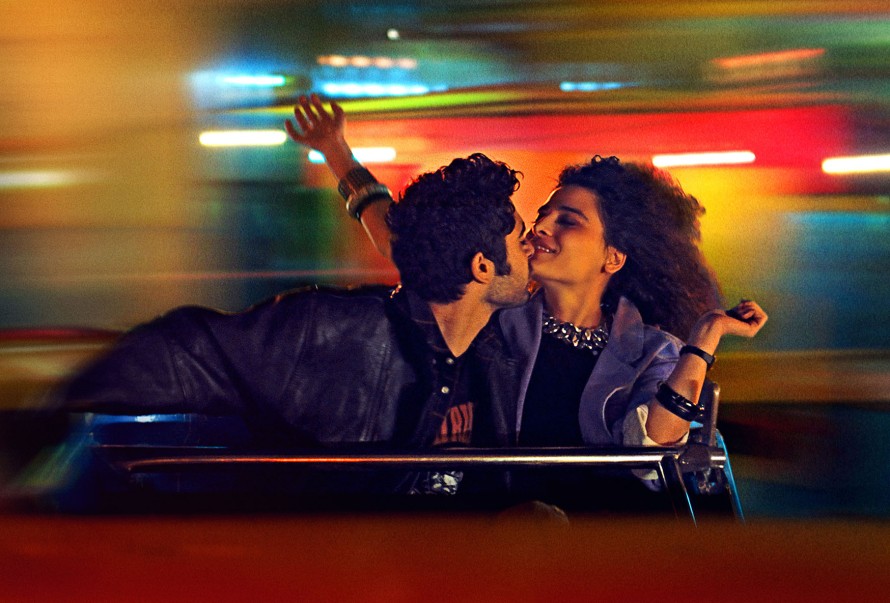
Hassan Akil and Manal Issa in Memory Box by Joana Hadjithomas & Khalil Joreige
With regard to the 2021 selection, you spoke of the reshaping of cinematic forms on the basis of traditional formats, like the fairy-tale or the science fiction genre. How important is that recourse to traditional narrative forms in the attempt to dare something new?
Carlo Chatrian: The cinematic form can be a guideline, enabling you to be more free and experimental. In the last years many filmmakers decided to use the genre as a sort of guideline for stories that were and are very personal. Sometimes a very strict one like the detective story, in other cases a more open one like the road movie. They resorted to the genre in order to reshape it. In a broader way, that may also be the answer to the uncertainties we are confronted with in the present time. But I think it’s hard to be theoretical about the situation and the lesson it teaches, because we are still in the middle of it.
One striking aspect of the selected films is the use of image types that one would not associate with cinema at first glance - social media selfies and in the case of Babardeală cu bucluc sau porno balamuc (Bad Luck Banging or Loony Porn) even the images of a porn film. Do you see some kind of aesthetic transformation in contemporary cinema?
CC: Not necessarily. Cinematic form is in constant movement and change and always influenced by the reality we are living in – for example social media aesthetics have become an integral part of the ways most people express themselves. Even when filmmakers don't think in a conscious way about their filmic means, they do represent the state they are living in. What we came to observe this year is that the filmmakers are well aware of the cinematic form they are using. Radu Jude for example uses a three-chapter structure, as do several other films in the selection. Babardeală cu bucluc sau porno balamuc is a triptych that employs diverse visual forms to paint a picture of contemporary Romanian society.
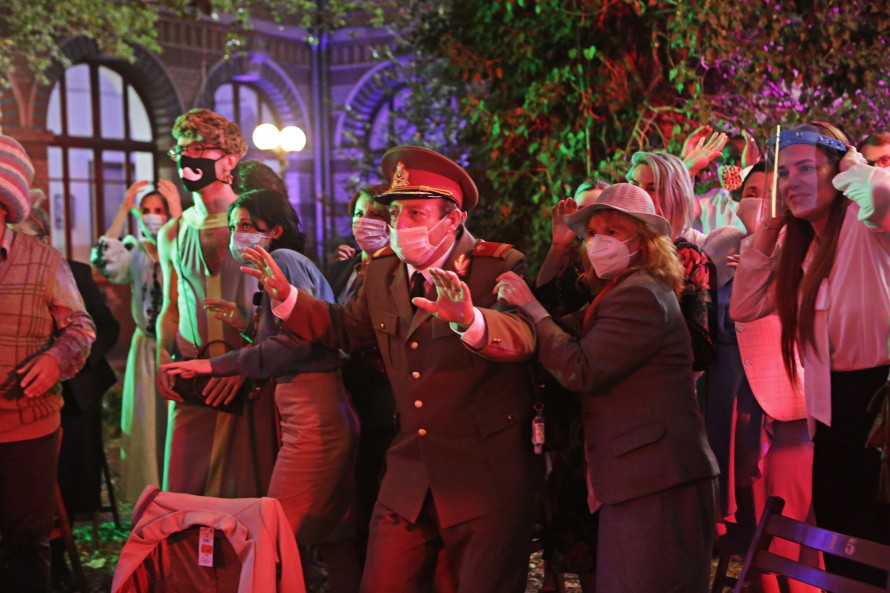
Paul Dunca / Paula Dunker, Nicoleta Lefter, Nicodim Ungureanu, Ana Ciontea, and Petra Nesvačilová in Babardeală cu bucluc sau porno balamuc (Bad Luck Banging or Loony Porn) by Radu Jude
Mark Peranson: We see filmmakers trying out forms, which are more “popular”. People consume them on a daily basis, for example porn videos, and they are used to see them on the screen. Now these images urge to the big, cinematic screen. But integrating these images is something experimental cinema and even Hollywood has done for years now. You have desktop movies like Unfriended (2014) by Levan Gabriadze or Profile (2018) by Timur Bekmambetov, taking place entirely on a computer screen, and also the rise of visual film criticism, which is also a kind of desktop cinema, just to state a few examples. Maybe the art film is coming a bit late to this as opposed to being ahead of the game because of the way films are produced and funded. I believe the pandemic has accelerated this process, Babardeală cu bucluc sau porno balamuc was shot last year and you very clearly see it's a movie realised during the pandemic – even though not thematically. It is obvious that the film would have looked differently, if it had been made three years ago. It’s like the filmmakers decided to look for something new in cinema because there are - at this point - really no rules.
20 years ago, in 2001, Intimacy by Patrice Chéreau won the Golden Bear and caused much discussion because of the then “explicit” sex scenes. Scenes that appear, compared to the beginning of Jude's film, quite tame.
CC: I don't think Radu Jude’s focus is on the depiction of sex. He starts with a popular form, like Mark said, and uses it as a trigger for negotiating something else: the hypocrisy that Romanian society has to deal with every day and now more than ever. And on the other hand the film is about the difficulty of being connected. That becomes evident not only by the fact that the actors wear masks, either when they are performing sex in order to protect their identity, or in the public life in order to protect their health or simply because that’s the rule. Each character is an island and they don't really talk to each other. Everyone stays in their own world of prejudices. Therefore the film is not about sex for me. Sex is about people being very close to each other. In Bardeală cu bucluc sau porno balamuc it is completely the opposite: everyone is isolated.
MP: But in a way the line to Intimacy can be drawn. Radu Jude is essentially taking this intimate moment and turns it into a social act: somebody uploads the video. And I think that's a way of contraposing what Intimacy has done 20 years ago. Sex has long been considered a very intimate act and at this point, sex doesn't necessarily have to be a personal matter anymore - or at least in certain cases it ends up not being. As Carlo said, everybody is sort of individually atomised at the end, but they are all basically talking about this intimate act, that would typically remain intimate. But because of the world we are living in today, those things end up being social. And in that sense the film is really a social commentary.
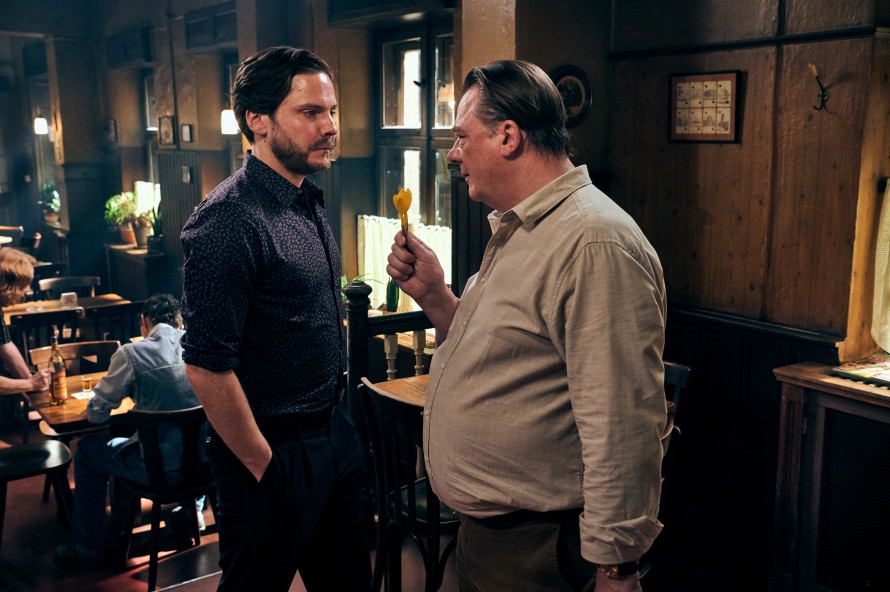
Daniel Brühl and Peter Kurth in Nebenan (Next Door) by Daniel Brühl
Bucharest seems to be the true main character in the film. The protagonist walks endlessly through the town, while the camera lets its gaze wander through the streets.
CC: Indeed. We have several films in the selection where the town becomes a real character… The town can also collapse into a single place, like the bar in Daniel Brühl’s Nebenan (Next Door). The space takes on a symbolic role and is thus elevated above its mere background function. In Alexandre Koberidze’s Ras vkhedavt, rodesac cas vukurebt? (What Do We See When We Look at the Sky?) the Georgian town of Kutaisi appears as a character, too. The more realistic the setting is, the closer it gets to the real places we know and the cinematic space provides something you usually don't have in a fiction film, because everything is created.
This testifies to a certain blending of the documentary with the fictional. A remarkable constellation in this respect can be found in the already mentioned Nebenan, in which the director Daniel Brühl seems to be playing himself, or at least the public image of himself.
CC: The leading character in the film is clearly someone who is very similar to Daniel Brühl. Someone who leads the same kind of life - affluent, acknowledged, famous. It’s a format which is called “autofiction” in France: to put yourself in a fictionalised surrounding. There is much playfulness in the film. What constitutes the film’s realness, its sense of documentary, is indeed the place: the “Kneipe”. The bar, the food, the wooden bench… On the other hand, the film is super-scripted and you recognise the way the dialogue informs the narrative. In that way, it mixes two universes: the sense of reality of the place and the most artificial part in a movie - because it comes from the mind and the intellect - the dialogue.
MP: You get a sense of truly being a part of what these characters are undergoing, because the movie is, in large parts, almost in real time. I think that’s what gives you so much of a documentary impression.
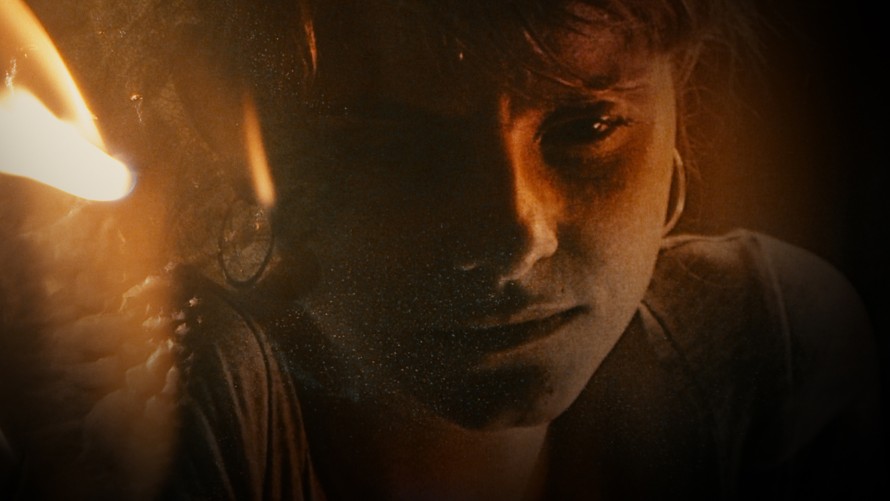
Juli Jakab in Rengeteg - mindenhol látlak (Forest - I See You Everywhere) by Bence Fliegauf
Una película de policías (A Cop Movie) by Alonso Ruizpalacios seems like an example of the pure reflection of this intermingling of documentary and fictional parts...
CC: And just like Daniel Brühl he uses the surface of a documentary to reflect on the image of an actor. Una película de policías even doubles this process by reflecting upon the image of actors playing police officers - an image that has been shaped by the movies, because it’s one of the most represented in cinema. Through its artificial structure the film exposes how this image of the policeman has been defined by cinema.
MP: What is interesting is that Ruizpalacios and the producers insisted that the film should be referred to as a documentary. So they are very much interested in redefining what a documentary can be, because when you have seen the film you understand that - traditionally speaking - most of it is not a documentary. They want people to decide for themselves what exactly a documentary is.
Plus: the film is very entertaining and the use of voice-over outstanding, this meandering narrative that seamlessly wanders between voice-over and dialogue and places the viewer in ever new relationships of distance and proximity to the characters. In Fabian oder Der Gang vor die Hunde (Fabian - Going to the Dogs) the voice of director Dominik Graf appears as an omnipresent narrator. Are these different types of focalisation characteristic of the selection?
CC: Indeed. We have a number of films that deal with being in and out of the fiction in the way the voice-over drags us in and throws us out of the narration in Una película de policías. Ras vkhedavt, rodesac cas vukurebt? has an even more present off-screen narrator. And yes, also Dominik Graf’s Fabian partly puts the spectator inside the frame and sometimes on the outside. The most elaborate work in that respect is Rengeteg - mindenhol látlak (Forest - I See You Everywhere) by Bence Fliegauf because it stages a multiverse of small stories. Each one drags you in, although they last just a few minutes. This mode of perception is reminiscent of the way we experience social reality during the lockdowns, because half of the day we are totally locked in a small window, staring at our monitor. So we are more used than ever to be in and out all the time.
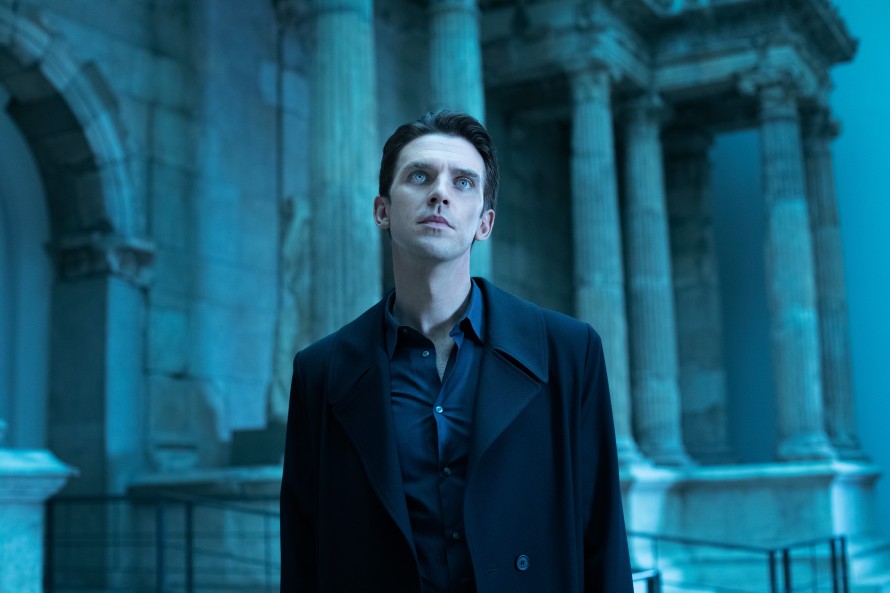
Dan Stevens in Ich bin dein Mensch (I'm Your Man) by Maria Schrader
This could be connected to Maria Schrader's Ich bin dein Mensch (I'm Your Man), in which a certain image of romantic desire has become manifest as a robot. Here, too, relationships alternating between proximity and distance play a central role. Can the figure of the robot Tom be read as a metaphor for cinema itself?
MP: I didn’t think of that, but it is true in a sense. Maybe you can say that because you’re dealing with artificial intelligence in Ich bin dein Mensch, like cinema, as we have been discussing, adapts with new forms, so artificial intelligence learns and adapts as it receives more information. But I think it's interesting as we started off in terms of genre and Maria Schrader’s film basically employs a very familiar genre – the romantic comedy - and just twists it a bit by adding a non-human character to the picture. The robot Tom and the scientist Alma come together, break up, come back together — and fall in love in the end.
CC: I think it’s quite the opposite: when cinema was created, as the latest result of a culture that really believed in progress, it was connected to the idea that it can work by itself, capturing images in a totally mechanic way, beyond all human interventions. In Ich bin dein Mensch you have an artificial intelligence that becomes more human than the human itself.
MP: That’s basically the moral of the story: because even though he’s a robot, he can learn how to change in the same way that she can. In the end, she realises she also has to change, so they can meet on some common ground. Maybe in 50 years, when the robots take over, we have to look back at this film and see that both the humans and the robots had to find some common ground.
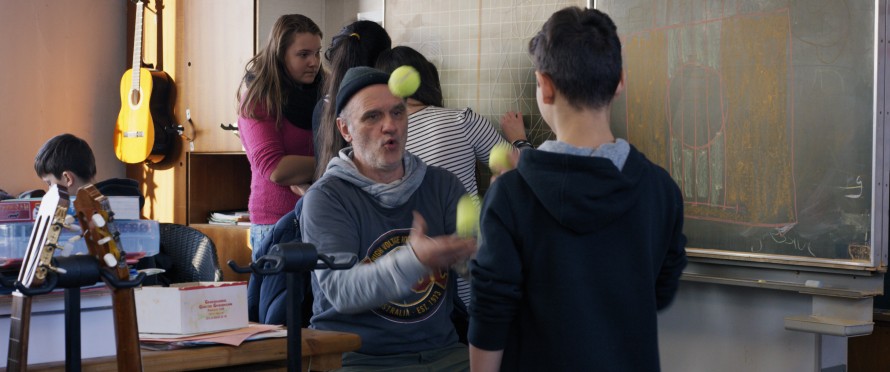
Herr Bachmann und seine Klasse (Mr Bachmann and His Class) by Maria Speth
Speaking of non-human agents ruling the world: last year, Corona was omnipresent. Has the virus also influenced your perception of films?
CC: For me the presence of the virus in seeing a film was strongest with the documentary Herr Bachmann und seine Klasse (Mr Bachmann and His Class), because our image of the school has completely changed due to COVID-19. It got futuristic, and is about students being connected without sharing the same place. In contrast, Maria Speth’s film is really about sharing one physical place. Watching the film is a very tactile experience, you almost have the impression to be touched by the images. Moreover, after you have watched Herr Bachmann und seine Klasse, you realise how many oppressions we now have in our everyday life.
Currently, the film could almost be understood as a plea to reopen the schools, so important is the contact between the teacher and his students...
CC: That’s true, but on the other hand - because we have discussed a lot about the documental and the fictional – this clearly is a documentary, showing exactly that class, with that teacher. It doesn’t represent all other classes and teachers. It’s very particular, although a great example and a model for what a school could be in a society.
MP: But the real pandemic classic - even if it is more than just a “pandemic movie” - in this year’s selection is Hygiène sociale (Social Hygiene) by Denis Côtè, which is in Encounters, not in Competition. If people understand the world through that movie, I think it’s something that I’d be in favour of. It doesn’t deal with the pandemic on the content level, it deals with it on a strictly physical representational level - in terms of positioning of bodies within frames, which is what cinema is. I’m very curious to see people’s reaction to that. It’s also very funny and you need to find some humour in times like these.